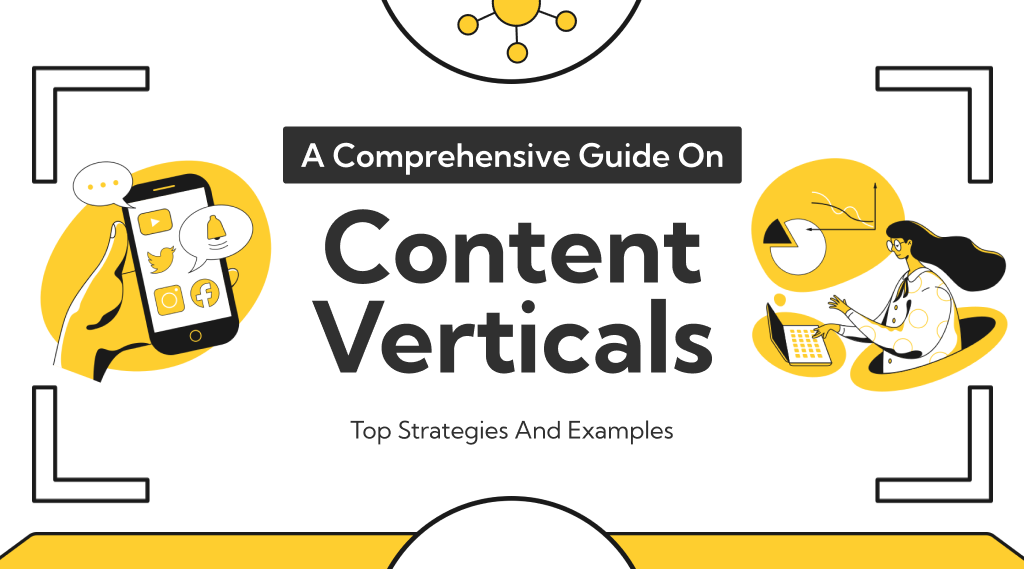Introduction
Success in the field of digital marketing depends on having a solid awareness of the subtleties involved in content production and dissemination. Of all the tactics and jargon, “content verticals” are one essential idea that can make a big difference in how successful your content marketing campaigns are. This is especially true for SaaS companies.
To throw you some facts, 73% of marketers use some sort of content marketing for the success of their business. So, understanding content verticals can help you optimize your content strategy whether you’re a seasoned marketer or a novice content writer.
But wait a sec. What are content verticals precisely, and why are they so crucial? Let’s discuss everything in detail in this blog!
What Is Content Vertical?
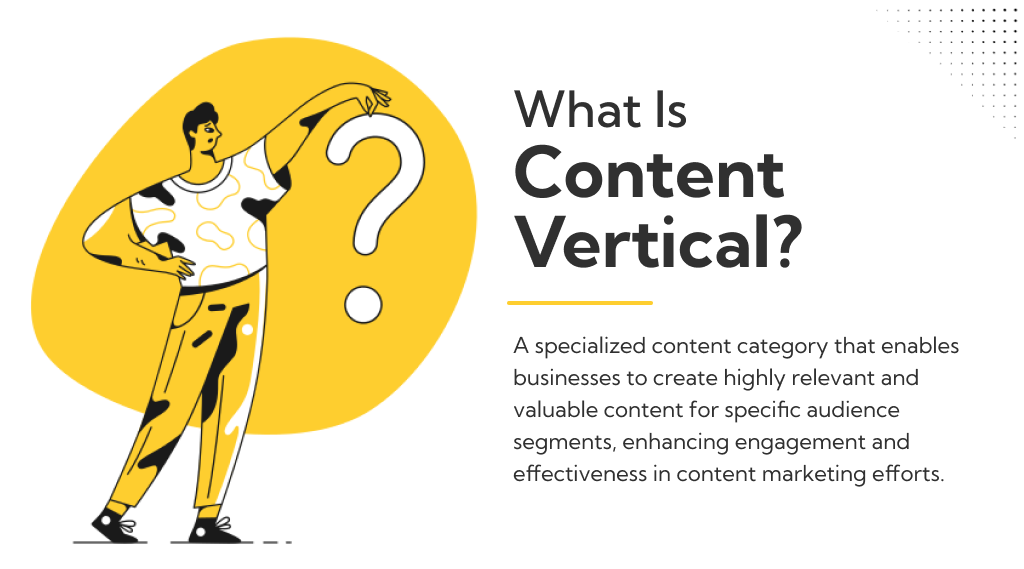
In the context of content marketing and strategy, a content vertical is a narrowly defined category or niche that serves as the focal point for the creation and organization of content. Vertical content focuses on a certain topic, industry, or theme, while horizontal content covers a wide range of topics. By assisting companies and content producers in customizing their messaging to a specific target audience, these verticals produce more interesting and pertinent content.
The increasing demand for specificity and customisation has given rise to content verticals. Organizations can cater to the distinct interests, requirements, and pain points of a specialized audience by focusing their content on that particular sector. This accuracy makes it possible for a content strategy to be more powerful and successful.
For instance, a software-as-a-service provider of project management tools might develop content verticals with a focus on various sectors like marketing, construction, or healthcare. They would create content for each vertical that was particular to the problems that the industry faced and the solutions that worked to solve them. This focused strategy can raise quality visitors and boost conversions, which will greatly improve the company’s content marketing efforts.
Horizontal Vs. Vertical Content
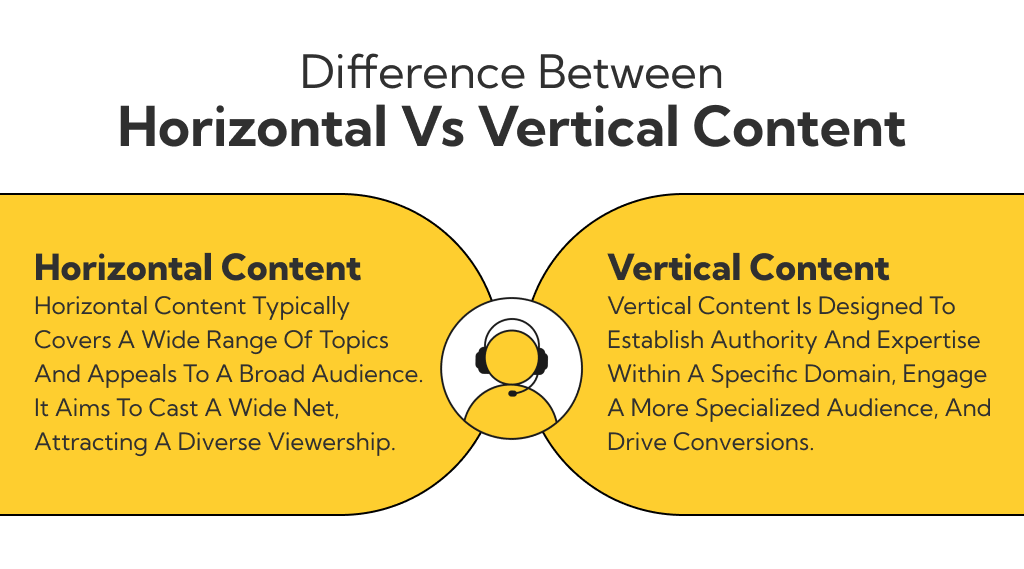
| Aspect | Horizontal Content | Vertical Content |
| Audience reach | The broad audience, diverse readers or viewers | Niche audience, specific market or sector |
| Purpose | Increase brand recognition, connect with a wider audience, produce recyclable material across platforms | Engage specific audience, promote conversions, build authority and knowledge within a particular domain |
| Content focus | Wide range of subjects (e.g., productivity hacks, career guidance, technological trends) | Specific topics in detail relevant to a particular industry’s challenges and software solutions |
| Engagement strategy | Attract a variety of readers or viewers | Speak to a very specific audience |
| Benefits | – Broad reach<br>- Enhanced brand exposure<br>- Increased overall engagement | – Thought leadership<br>- Strong connection with specific audience<br>- Higher relevance and customization |
| Examples | Generic software company creates content on general productivity hacks and technological trends | Software company creates content addressing specific challenges in a particular industry |
| Use Case in SaaS | Used for general brand exposure and to appeal to a wide array of potential users | Crucial for addressing specific requirements, fostering relationships, and increasing engagement with target market |
| SEO and content strategy | Focus on broader keywords, general trends | Focus on specific keywords, detailed industry topics |
| Marketing goals alignment | Best for brand exposure and overall engagement | Best for developing thought leadership and building a strong connection with a specific audience |
| Content strategy balance | Often used to cast a wide net and draw initial interest | Used to delve deep into specific issues, providing value to a targeted audience |
Benefits Of Content Verticals In SaaS Content Strategy
Content verticals, first and foremost, enable SaaS companies to address the unique requirements and preferences of their target market. Through content segmentation into discrete verticals that correspond with diverse industries, user profiles, or pain concerns, businesses can furnish incredibly pertinent and customized information. This degree of detail strengthens relationships and increases engagement with prospective clients.
1. Personalization and Relevance
By creating content specific to various industries or user segments, SaaS companies can deliver targeted messaging that resonates more deeply with each audience. Tailoring content to address the specific challenges and needs of different verticals enhances the user experience, making the information more useful and actionable for potential clients.
2. Authority and Credibility
Content verticals assist SaaS providers in becoming recognized authorities in the markets they target. By continually offering comprehensive information that tackles issues unique to the sector, they establish themselves as authorities in the domain. Regularly publishing expert insights, case studies, and industry reports helps SaaS companies build thought leadership, further cementing their reputation as industry leaders.
3. Improved SEO Performance
Focusing on specific verticals allows for better keyword optimization tailored to the terminology and search behaviors of different industries, improving organic search rankings. Creating content clusters around each vertical can boost SEO performance by enhancing the relevance and authority of the website in the eyes of search engines.
4. Sales and Conversion Enhancement
Providing in-depth content for each vertical educates potential buyers, helping them make informed decisions and increasing the likelihood of conversion. Highlighting how the SaaS product solves specific problems within each vertical can drive higher engagement and conversion rates.
5. Customer Retention and Loyalty
Continuously delivering valuable, sector-specific content helps maintain customer interest and engagement, leading to higher retention rates. Engaging with users through content that speaks directly to their industry can foster a sense of community and loyalty among clients.
6. Competitive Advantage
By excelling in multiple verticals, SaaS companies can differentiate themselves from competitors who may offer more generalized solutions. A strategic focus on content verticals can facilitate deeper market penetration, allowing companies to establish a strong presence in various sectors.
What Are The Three Main Types Of Content Verticals?
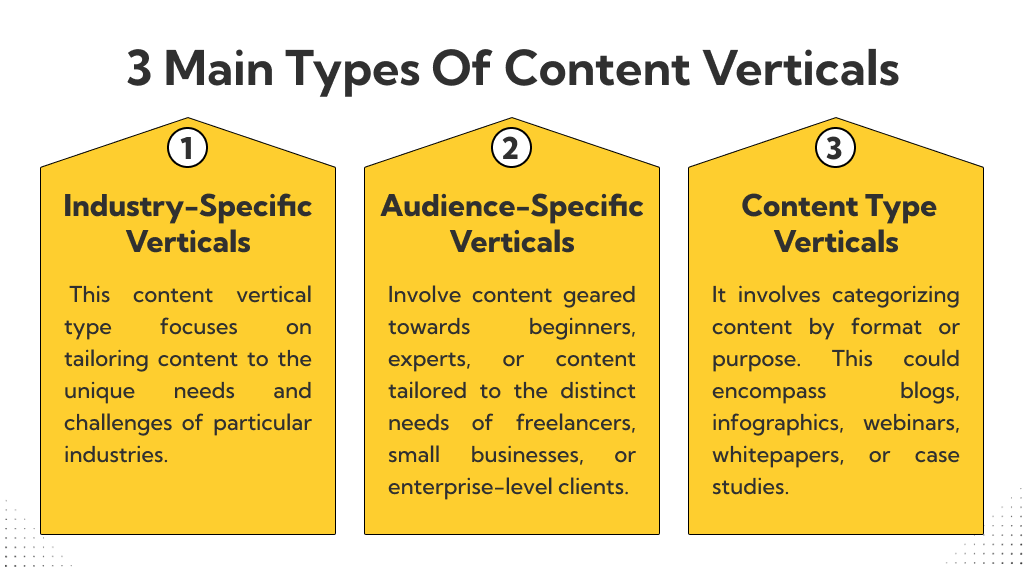
Within a SaaS content strategy, the three main categories of content verticals provide unique methods for customizing content for particular industries, audience segments, or niches.
1. Industry-specific verticals
The goal of this sort of content vertical is to customize content to meet the special requirements and difficulties faced by specific businesses. SaaS providers are able to produce content that specifically targets problems and offers answers for sectors such as manufacturing, healthcare, and finance. For example, a financial software SaaS supplier might produce material tailored to the banking business that addresses regulatory concerns or financial trends.
2. Audience-specific verticals
These verticals focus on producing content tailored to specific user groups’ needs. Content for novices, professionals, or material catered to the particular requirements of independent contractors, small enterprises, and so on. A software-as-a-service (SaaS) provider of project management tools might provide content verticals targeted at both experienced users and beginners, according to their needs for sophisticated capabilities and intricate integrations.
3. Content type verticals
These verticals involve the format or purpose-based classification of content. Blogs, infographics, webinars, whitepapers, and case studies may all fall under this category. SaaS companies are able to provide content that corresponds with user preferences and their stage in the buyer’s journey because each form of content has a specific purpose within the marketing funnel. A SaaS vendor might, for example, create a content vertical dedicated solely to educational webinars meant to enlighten prospective clients.
Best Practices To Implement The Perfect Vertical Content Strategy
Implementing the ideal vertical content strategy calls for careful planning and strategic thinking. The following best practices will assist you in maximizing the impact of your content verticals:
1. Audience research
To start, make sure you fully comprehend each vertical’s target audience. Determine their preferences, interests, and areas of suffering. Your content creation will be guided by this knowledge.
2. Clearly defined verticals
Clearly and distinctly define each vertical of the material. To stay relevant and prevent confusion, make sure each vertical focuses on a certain industry, niche, or target area.
3. Content planning
Create a content strategy that fits each vertical’s requirements as well as your marketing objectives. A publication schedule, topic ideas, and a content calendar should all be part of this.
4. Consistency
Consistency is crucial. For each vertical content strategy you are using, stick to a regular posting schedule to keep your audience interested and informed.
5. Keyword research
To make your content more search engine friendly, conduct keyword research for every content vertical. This will increase how easily people can find your material.
6. Content promotion
Customize your marketing initiatives for every sector. To increase reach within that speciality, distribute content through groups, influencers, and channels tailored to that industry.
7. Analytics and KPIs
Keep a close eye on KPIs (key performance indicators) that are unique to each vertical, like conversion rates and engagement metrics. Make use of these insights to improve your approach.
7 Content Verticals Examples
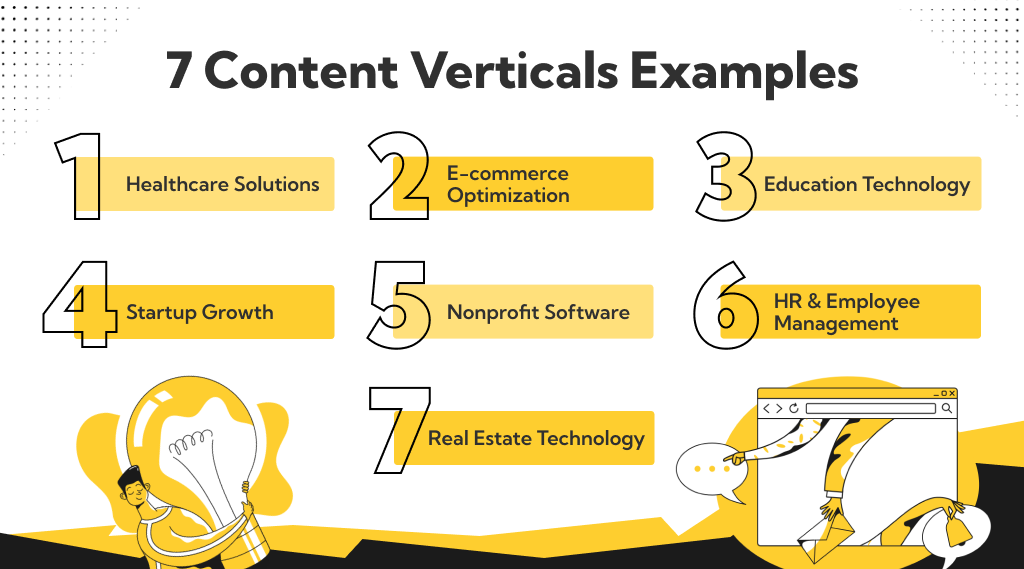
To help you get a clearer picture, here are seven content vertical examples that illustrate how different industries and niches can benefit from this approach:
Healthcare solutions
Software as a service (SaaS) providers in the healthcare space can create a content vertical devoted to tackling the particular compliance and data security issues facing the sector. Whitepapers on HIPAA compliance, case studies of effective implementations, and webinars on the latest developments in telemedicine are a few examples of possible content.
E-commerce optimization
Software as a service (SaaS) companies that cater to e-commerce companies might establish a content vertical with the goal of enhancing online sales and consumer satisfaction. Articles for improving conversion rates, how-to videos for integrating e-commerce technologies, and manuals for creating efficient product listings are examples of content.
Education technology
Resources for teachers, students, and administrators can be found in EdTech content verticals. These could be reports on the newest developments in online education, student success stories, or lesson plans for educators.
Startup growth
Software as a Service (SaaS) providers that work with startups can create a content vertical that addresses the particular difficulties that these organizations confront. This content might include expert interviews on entrepreneurship, operations scaling instructions, and company success stories.
Nonprofit software
This industry’s content verticals might concentrate on assisting nonprofits in utilizing software to increase their impact. Content could include case studies that showcase the accomplishments of nonprofit clients, donor management best practices, and advice on obtaining grants.
HR and employee management
Human resources-related SaaS solutions can establish a content vertical with an emphasis on HR best practices. Content like staff retention tactics, tool comparisons for HR departments, and manuals for managing remote teams could fall under this category.
Real estate technology
Content verticals for SaaS companies catering to the real estate industry may include tools for property managers and real estate brokers. Reports on market analyses, property tours on video, and analyses of property management software are examples of content.
The adaptability of this method in customizing content to the particular requirements and preferences of particular businesses and consumers is demonstrated by these examples of content verticals. SaaS companies may boost engagement, build authority, and encourage conversions in their targeted niches by doing this.
Conclusion
The perfect vertical content strategy is a powerful tool for SaaS companies seeking to optimize their content marketing efforts.
SaaS organizations looking to maximize their content marketing efforts can benefit greatly from having the ideal vertical content strategy.
If you feel the same, reach out to us. We at RevvGrowth have been growing SaaS companies to greater heights for ages. Let’s have a quick chat over a cup of coffee to discuss how we can help you.
🚀 Ready to Supercharge Your SaaS Marketing?
Discover the ultimate growth partner at revvgrowth.com!
- Unleash the Power of Data-Driven Marketing
- Turbocharge Your SaaS Sales Funnel
- Elevate Your Brand in the SaaS Space
FAQs
What is the difference between content verticals and content categories?
Content verticals are specific, niche topics. Content categories are broader themes that include multiple verticals.
How do content verticals impact SEO strategy?
Content verticals improve SEO by creating focused, relevant content that ranks better and attracts more organic traffic.
Can content verticals be used in social media marketing?
Yes, they help create targeted, engaging content that attracts and retains followers interested in specific topics.
How do you identify the right content verticals for your business?
Research your audience’s interests, analyze industry trends, and assess your brand’s strengths to find relevant topics.
What are the benefits of focusing on specific content verticals?
They increase engagement, build authority, streamline content creation, and improve SEO performance.
